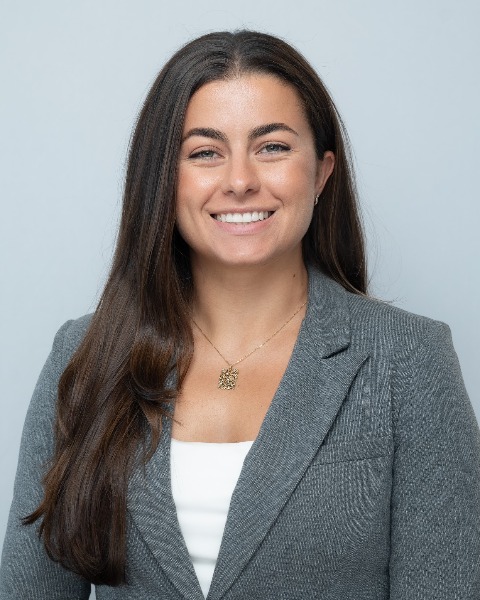Deformity
Adolescent vs. Young Adult Idiopathic Scoliosis Patients: Should an older teen wait until adulthood to have a spinal fusion?
Friday, February 21, 2025
7:00 AM - 2:00 AM EST

Alexandra Dionne, BA
Medical Student
Columbia University
Presenting Author(s)
Introduction: Limited evidence suggests that pts with idiopathic scoliosis (IS) operated on as adolescents (AIS) versus young adults (YAdIS) have better postoperative alignment and fewer surgical complications.
Methods: AIS pts of all Lenke curve types with primary corrective surgery with minimum 2yr follow-up were stratified as Adolescent (AIS: age10-18) or Young Adult Idiopathic Scoliosis (YAdIS: age19-40). Exclusion criteria were fusion to sacrum and prior spine surgery. 1:1 propensity score matching (PSM) was done based on curve type, gender, main coronal cobb angle, and instrumented levels. Demographics, intraoperative/long-term postoperative complications, radiographic alignment, and patient-reported outcomes (PROs) including the Oswestry Disability Index (ODI) and SRS-22r survey were analyzed.
Results: After 1:1 PSM, 237 patients (AIS:145, YAdIS: 92) generated 2 groups of 27 patients with identical gender ratio and curve types. AIS had lower Hb and Hct than YAdIS (11.8 [1.9] vs 13.2 [1.2] and 35.2 [5.5] vs 39.4 [3.3], p=0.0213 and 0.0147 respectively) and expected lower age and BMI (p < 0.05). Preoperative radiographic parameters were equal, except that YAdIS had greater lordosis (55.6 [14.0] vs 61.8 [11.7], p=0.0486). AIS had lower OR time (4.7 [1.2] vs 5.2 [1.5] hrs, p=0.0468), intraoperative transfusion rates (70.4% vs 96.3%, p=0.0082), and postoperative Hb/Hct (p < 0.05). Other intraoperative outcomes and complications were the same (EBL, transfused pRBC/CS, SSI, dural tears, NR weakness, all with p>0.05). Postoperatively, AIS had less hypotension (7.4% vs 25.9%, p=0.0253) and received fewer pRBCs (1.0 [0.0] vs 1.6 [0.8], p=0.0400). YAdIS had greater T2-T12 TK (36.3 [11.0] vs 42.7 [13.6], p=0.0412), T2-T5 TK (13.3 [8.7] vs 19.4 [9.4], p=0.0187), and T1PA (7.4 [8.9] vs 12.4 [7.9], p=0.0200). The magnitude of correction was equal except that YAdIS had greater T1PA (1.0 [5.1] vs 5.3 [5.0],p=0.0060) and lower CVA (-0.9 [2.0] vs 0.6 [2.1] cm, p=0.0085), indicating greater AIS coronal correction to the left and YAdIS to the right. Long-term complication/revision rates and baseline/follow-up PROs were equivalent (p>0.05).
Conclusion : AIS patients have lower OR time, intraoperative transfusion rate, postoperative pRBCs, and hypotension, but have comparable perioperative and long-term complication/revision rates and PROs to YAdIS. They have smaller T2-T12TK, T2-T5 TK and T1PA, with more left vs right CVA correction.
Methods: AIS pts of all Lenke curve types with primary corrective surgery with minimum 2yr follow-up were stratified as Adolescent (AIS: age10-18) or Young Adult Idiopathic Scoliosis (YAdIS: age19-40). Exclusion criteria were fusion to sacrum and prior spine surgery. 1:1 propensity score matching (PSM) was done based on curve type, gender, main coronal cobb angle, and instrumented levels. Demographics, intraoperative/long-term postoperative complications, radiographic alignment, and patient-reported outcomes (PROs) including the Oswestry Disability Index (ODI) and SRS-22r survey were analyzed.
Results: After 1:1 PSM, 237 patients (AIS:145, YAdIS: 92) generated 2 groups of 27 patients with identical gender ratio and curve types. AIS had lower Hb and Hct than YAdIS (11.8 [1.9] vs 13.2 [1.2] and 35.2 [5.5] vs 39.4 [3.3], p=0.0213 and 0.0147 respectively) and expected lower age and BMI (p < 0.05). Preoperative radiographic parameters were equal, except that YAdIS had greater lordosis (55.6 [14.0] vs 61.8 [11.7], p=0.0486). AIS had lower OR time (4.7 [1.2] vs 5.2 [1.5] hrs, p=0.0468), intraoperative transfusion rates (70.4% vs 96.3%, p=0.0082), and postoperative Hb/Hct (p < 0.05). Other intraoperative outcomes and complications were the same (EBL, transfused pRBC/CS, SSI, dural tears, NR weakness, all with p>0.05). Postoperatively, AIS had less hypotension (7.4% vs 25.9%, p=0.0253) and received fewer pRBCs (1.0 [0.0] vs 1.6 [0.8], p=0.0400). YAdIS had greater T2-T12 TK (36.3 [11.0] vs 42.7 [13.6], p=0.0412), T2-T5 TK (13.3 [8.7] vs 19.4 [9.4], p=0.0187), and T1PA (7.4 [8.9] vs 12.4 [7.9], p=0.0200). The magnitude of correction was equal except that YAdIS had greater T1PA (1.0 [5.1] vs 5.3 [5.0],p=0.0060) and lower CVA (-0.9 [2.0] vs 0.6 [2.1] cm, p=0.0085), indicating greater AIS coronal correction to the left and YAdIS to the right. Long-term complication/revision rates and baseline/follow-up PROs were equivalent (p>0.05).
Conclusion : AIS patients have lower OR time, intraoperative transfusion rate, postoperative pRBCs, and hypotension, but have comparable perioperative and long-term complication/revision rates and PROs to YAdIS. They have smaller T2-T12TK, T2-T5 TK and T1PA, with more left vs right CVA correction.

.jpg)